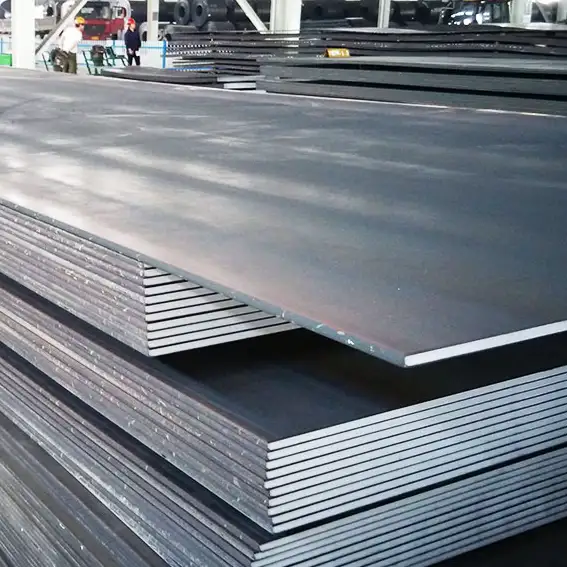ASTM A240 Type 2205 duplex stainless steel sheet delivers superior corrosion resistance and strength at a premium compared with common austenitic grades; typical wholesale prices in 2025 range broadly (rough guidance) from roughly USD 4–12 per kg depending on form, finish, order quantity, and region. For competitive procurement from China with factory-direct terms, MWAlloys offers 100% factory pricing and fast stock delivery for standard 2205 sheet sizes.
What is ASTM A240 Type 2205?
ASTM A240 covers stainless steel plate, sheet, and strip intended for pressure vessels and general engineering. Type 2205 (commonly referenced by UNS S32205 or S31803) is a duplex stainless steel with roughly 22% chromium, ~5% nickel, molybdenum and nitrogen additions that produce a two-phase (austenitic + ferritic) microstructure. That combination yields higher yield strength and improved chloride stress-corrosion cracking resistance versus 300-series grades. The grade is widely used in chemical processing, desalination, oil and gas, and pulp & paper industries.
Why buyers choose 2205?
2205 is selected when chloride corrosion resistance must improve without the cost of higher-nickel or super-duplex alloys. It trades modestly higher metal cost for lower lifecycle expense through longevity and reduced maintenance.
Key material properties (chemistry, density, mechanicals)
Typical chemical composition (range): C ≤0.03%, Cr ≈21–23%, Ni ≈4.5–6.5%, Mo ≈2.5–3.5%, N ≈0.08–0.20%, Mn ≤2%, Si ≤1%, P ≤0.03%, S ≤0.02%. This tightened chemistry was defined to optimize corrosion performance.
Microstructure: Approximately equal ferrite and austenite phases; careful thermal processing required to avoid intermetallic sigma phase formation in heavy sections.
Density: Around 7.8–7.9 g/cm³ (≈0.283 lb/in³). Use 7.85 g/cm³ for conservative weight calculations unless the mill provides a certified value.
Mechanical properties (typical):
-
Tensile strength: often 620–850 MPa (depending on form/heat treatment).
-
Yield strength (0.2% offset): typically ~450–550 MPa (higher than 300-series).
-
Elongation: usually 20–30% in 50 mm gauge for plate.

Standard sizes, thicknesses and weight reference table (sheet/plate)
Below is a practical weight-per-square-meter table for 2205 sheet/plate using density 7.85 g/cm³ (multiply thickness in mm × 7.85 to get kg/m²).
| Thickness (mm) | Weight (kg/m²) |
|---|---|
| 0.5 | 3.925 |
| 1.0 | 7.85 |
| 1.2 | 9.42 |
| 1.5 | 11.78 |
| 2.0 | 15.70 |
| 2.5 | 19.63 |
| 3.0 | 23.55 |
| 4.0 | 31.40 |
| 5.0 | 39.25 |
| 6.0 | 47.10 |
| 8.0 | 62.80 |
| 10.0 | 78.50 |
| 12.5 | 98.13 |
| 15.0 | 117.75 |
| 20.0 | 157.00 |
Standard commercial widths and lengths vary by mill; typical widths: 1,000 mm, 1,250 mm, 1,500 mm, 2,000 mm; standard plates up to large dimensions are available. Confirm with mill for available coil vs plate sizes.
Historical price table: past five years
Methodology note: Duplex 2205 is priced using mill/merchant quotes and regional indices. The table below aggregates public merchant price ranges and regional stainless indices to produce a conservative annual view in USD per metric tonne (mt) for standard hot-rolled 2205 plate/sheet for bulk orders. Prices can differ significantly by order size, finished surface, and contractual INCOTERM.
| Year | Indicative Average FOB price (USD/tonne) — bulk factory orders (approx.) |
|---|---|
| 2021 | 3,200 – 3,800 |
| 2022 | 4,200 – 5,500 |
| 2023 | 3,700 – 4,800 |
| 2024 | 3,500 – 4,500 |
| 2025 (YTD) | 3,800 – 6,000 |
Notes & sources: 2022 saw a global spike due to raw-material and supply constraints; subsequent years softened but remained volatile because of energy and logistics changes. Exact buyer quotes vary: cold-rolled and specialty finishes command higher premiums. Regional merchant pages and price aggregators show per-kg merchant listings in mid-single to low-double digits USD; converting those to tonnes produces the ranges above.
Regional price comparison — typical 2025 (FOB factory/merchant ranges)
Important: Prices below are approximate ranges representing typical FOB or EXW merchant quotes in mid-2025 for standard 3–6 mm hot-rolled 2205 sheet in reasonable quantities (metric tonnes). Always obtain live mill quotes for contractual procurement.
| Region | Typical Price (USD/kg) | Typical Price (USD/tonne) |
|---|---|---|
| China (factory/merchant) | 3.5 – 6.0 USD/kg | 3,500 – 6,000 / t |
| USA (merchant, mill stock) | 6.0 – 10.5 USD/kg | 6,000 – 10,500 / t |
| Europe (EU mills / distributors) | 5.0 – 9.0 USD/kg | 5,000 – 9,000 / t |
Explanatory points: China often lists the most competitive factory prices because of local mill capacity and domestic supply chains. US/Europe prices include higher mill overheads and regulatory/inspection costs. Freight, duties, and VAT influence landed cost in each market. For an apples-to-apples comparison include surface finish, test certificates, and packaging.
Major factors that influence 2205 sheet price
-
Raw material inputs: Nickel, chromium, molybdenum, and nitrogen feedstocks determine alloy premium. Nickel and molybdenum price swings are especially impactful.
-
Finished form and testing: Cold-rolled, annealed, pickled and passivated finishes, and full mill test certificates increase cost.
-
Order quantity and mill capacity: Small orders attract higher unit premiums; large repeats get mill discounts.
-
Energy and scrap prices: Mills’ operational costs (energy) and stainless scrap availability shift mill margins.
-
Logistics & freight: Ocean freight volatility, insurance, and port congestion create time-based premiums.
-
Trade measures & duties: Anti-dumping duties, quotas, or environmental levies can raise landed cost by region.
-
Currency exchange: USD vs RMB vs EUR movements change real buyer cost.
-
Product spec & tolerances: Tight tolerances, certified traceability, and NDT raise the price.
-
Market demand cycles: Upstream projects (oil & gas, desalination) increase demand and push prices up.
-
Substitute availability: Competing grades (2201, 2507, 316L) affect buyer willingness to pay.
Five-year outlook (2026–2030)
Base assumptions: Slow global GDP growth, ongoing energy transition, and intermittent supply constraints. Three plausible scenarios:
-
Conservative scenario (moderate rise): Stable industrial demand; nickel and molybdenum prices increase modestly. Expect +3–8% CAGR for 2205 unit prices through 2030.
-
Bull scenario (supply squeeze / strong demand): Large project rollouts or tight scrap feed lead to +10–20% CAGR.
-
Soft scenario (recession / oversupply): Demand slumps and mills seek market share — flat to −5% CAGR.
What procurement teams should do: secure framework contracts with price-review clauses, lock partial volumes under favorable terms during dips, require clear mill QC documents, and specify acceptable substitutes with technical approval paths.
How to buy economically — procurement checklist
-
Define exact spec: ASTM A240 Type 2205, UNS S32205, required thickness, finish, mechanical properties, NDT, and test certificate level.
-
Decide on incoterms early (EXW/FOB/CIF) to compare apples-to-apples.
-
Ask suppliers for mill test certificates (MTC EN 10204/3.1 or 3.2 where applicable).
-
Evaluate lead time vs cost — express orders carry premiums.
-
Bundle quantity for better unit pricing; consider consignment stock for recurring needs.
-
Verify supplier metallurgical capability (heat treatment, ultrasonic testing).
-
Include freight, duties, and local handling costs in total landed cost.
-
For China purchases, specify export packing and port of loading; MWAlloys supports factory packing and quick stock shipments.
FAQs
1. What is the typical price per kg for 2205 sheet in 2025?
For bulk factory orders in 2025, expect roughly USD 3.5–6.0 per kg in China, USD 5–10+ per kg in Europe/USA depending on finish and documentation. Always obtain live quotes for specific thickness and quantity.
2. Is 2205 suitable for seawater service?
Yes; 2205 offers substantially better chloride pitting and SCC resistance than 304/316 families, making it a common choice for seawater handling and desalination components when cost is a constraint.
3. How much does 1 mm of 2205 sheet weigh per m²?
At density 7.85 g/cm³, 1 mm = 7.85 kg/m².
4. Can 2205 be welded easily?
2205 weldability is good when correct filler and pre/post practices are applied. Avoid overheating and ensure ferrite/austenite balance in the weld metal. Request welding procedure specifications (WPS) from the supplier.
5. How to verify 2205 authenticity?
Request full mill test certificates (chemical & mechanical), verify heat/heat numbers, and optionally perform independent lab tests (chemistry analysis, hardness, pitting testing).
6. Are there common substitutes to 2205?
For lower cost, duplex leaner grades exist; for higher corrosion resistance, super-duplex (e.g., 2507) is an alternative. Substitutes require technical approval.
7. What delivery times should I expect from factory in China?
For stocked items MWAlloys can ship quickly (days to two weeks). For new mill production lead times can vary from 2–8 weeks based on thickness and order size.
8. Are there environmental/chemical restrictions that affect 2205 price?
Yes; environmental regulation increases refinery/steelmaker costs; restrictions or carbon levies can affect mill pricing indirectly.
9. Does surface finish affect price?
Yes; polished, cold-rolled or ground surfaces increase unit cost versus hot-rolled, as does additional passivation or pickling.
10. How to get the best landed price?
Negotiate larger volumes, use FOB/EXW to control logistics, consolidate shipments, and specify acceptable finishes and certificate levels to avoid overpaying for unnecessary extras.

